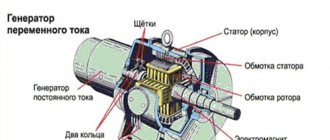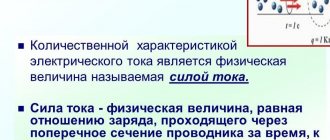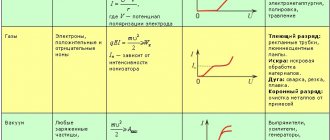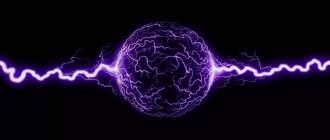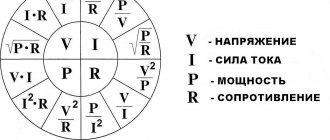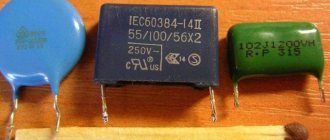In this article we will tell you what electrical power is and how it can be calculated.
Definition.
Electric current power (denoted by the letter P) is a physical quantity defined as the amount of work done by a source of electrical voltage to transfer electric charge (q) along a conductor per unit time t.
Generally speaking, the power of an electric current shows how much electrical energy is converted in a certain time. It also describes the consumer’s energy consumption.
Formulas
Many household electrical appliances have labels indicating their wattage. Power (P) refers to the work (A) performed by an electrical appliance per unit of time (t). Therefore, in order to find the average power of the electric current, it is necessary to divide its work by time, that is, P = A / t.
Let's look at what electric power is. To do this, consider an electrical circuit (see Figure 1), consisting of a current source, wires and some kind of electrical receiver, which can be a resistor, battery, electric motor, etc.
Rice. 1. An electrical circuit in which the voltage and current are constant
The recommended electrical voltage is also indicated on the electrical equipment. How are these two quantities related to each other? From a school physics course, we know that the voltage (U) between the ends of a given electrical receiver is determined as follows: U = A / q, where: A is the work done by the source of electrical voltage to transfer electric charge (q) along the conductor.
The amount of electric charge is calculated by the formula: q = I * t
We have A = P * t; A = U*q, and q = I * t. After transforming the formulas we get: A = P*t = U*q = U*I*t
It follows (by dividing both sides of the equation by t) that P = U*I. That is, we can say that the amount of energy transferred from the current source to the resistor is determined by the formula: P = U * I
From this formula we can find that U = P / I, I = P / U.
According to Ohm's law for a circuit section I = U/R, where R is the electrical resistance of the circuit section. Therefore, from the formula P = U*I, two other formulas for the power of electric current follow, that is, P = U2/R, P = I2R.
The formula P = I2R is convenient to use for electrical circuits with a series connection of conductors, because the strength of the electric current in such a connection in the conductors is the same.
For parallel-connected conductors, it is more convenient to express work and power through the same electrical voltage for them, excluding the strength of the electric current, i.e. it is better to use the formula P = U2/R.
If electrical appliances are connected in series or in parallel, their electrical power is summed up. In this case, to calculate the total power, the following formula is used:
Ptotal = P1 + P2 + … + Pn, where P1, P2, … is the power of individual electrical receivers.
Notes[ | ]
- Power
- article from the Physical Encyclopedia - Physics. - P. 100. Chapter 6 “Work and Energy”, § 3 “Power”.
- ISO 80000-4:2019 “Quantities and units — Part 4: Mechanics” Item 4.27
- Physics. - P. 100. Chapter 6 “Work and Energy”, paragraph 3 “Power”.
- GOST 8.417-2002. — P. 5. P.5.2 “Derived SI units”, table 3 “Derived SI units with special names and designations.”
- OIML International Document D2. Legalized (officially approved for use) units of measurement. Appendix B (unspecified)
(inaccessible link). Access date: April 5, 2013. Archived October 14, 2013. - NP-89D. Description. Specifications. Units produced by OJSC MMZ Znamya
Units of measurement and designation
The unit of power in the International System of Units (SI) is the watt. In this case, the Russian designation: W , international: W ). 1 W = 1 J/s. From the formula P = U*I it follows that: 1 watt = 1 volt * 1 ampere, or 1 W = 1 VA.
There are also power units that are multiples of watts: hectawatt (gW), kilowatt (kW), megawatt (MW). In other words, 1 GW = 100 W, 1 kW = 1000 W, 1 MW = 1,000,000 W.
The units of power used in electrical engineering are multiples of the watt: microwatt (µW), milliwatt (mW), hectowatt (gW), kilowatt (kW) and megawatt (MW). In other words, 1 µW = 1*10-6 W, 1 mW = 1*10-3 W, 1 gW = 1*102 W, 1 kW = 1*103 W, 1 MW = 1*106 W.
Each electrical appliance has a certain power (indicated on the device). Here are typical wattage ratings for some electrical appliances.
| Device | Power, W |
| TV in standby mode | 0,5 |
| Flashlight lamp | About 1 |
| Incandescent lamps | 25-150 |
| Fridge | 160 |
| Electric heater | 500-2000 |
| Vacuum cleaner | Up to 1300-1800 |
| Electric kettle | Around 2000 |
| Iron | 1200-2200 |
| Washing machine | Up to 2300 |
Previously, the unit of measurement used to denote power was horsepower (hp), which is still known today. Convert from horsepower to watts using the expression: 1 hp. = 735.5 W.
Hydraulic power[ | ]
The power of a hydraulic machine or hydraulic cylinder is equal to the product of the pressure drop across the machine (the pressure difference at the inlet and outlet) and the fluid flow rate:
NH = QH ⋅ PH , {\displaystyle N_{H}=Q_{H}\cdot P_{H},} where QH {\displaystyle Q_{H}} is liquid flow rate, m3/s; PH {\displaystyle P_{H}} — pressure drop, .
For example, the NP-89D pump found on the Su-24, Tu-134 and Tu-154 has a capacity of 55 l/min (~0.000917 m3/s) at a pressure of 210 kgf/cm2 (21 MPa)[7] - therefore, its hydraulic power is approximately 19.25 kW.
An example of calculating the power of electric current
In the end, you will be able to test your knowledge with 2 common examples.
Imagine that in the first problem you have a resistor R = 50 Ohm through which an electric current I = 0.3A flows. What electrical power is converted in this resistor?
You can find the solution by finding the appropriate formula and plugging in the given values into it. That is, we get: P = I2R = 0.32 * 50 = 4.5 W
In the second problem, a resistor R is given, the electrical resistance of which is 700 Ohms. The technical description states that the maximum power of this resistor is 10 W. How high can the voltage applied to this resistor be?
To solve this problem, we select the appropriate formula: P = U2/R, from where we find Umax = Pmax * R = 700 * 10 = 83.67 V.
This means that the maximum voltage can be 83.67 V. To be on the safe side, you should choose an electrical voltage well below this limit.
I wrote in more detail about how to find the power of an electric current in the article:
Gravity, weight, mass, density
Formulas, concepts and definitions that describe these physical characteristics are studied in 7th grade as part of a section of physics called dynamics.
| The weight of a body or substance is a physical quantity that characterizes the force with which it acts on a horizontal surface or vertical suspension. |
Please note: body weight is measured in newtons, body mass in grams and kilograms.
Weight formula:
P = mg, where m is the mass of the body, g is the acceleration of gravity.
The acceleration of free fall occurs under the influence of gravity, to which all bodies on our planet are subject.
g = 9.806 65 m/s2 or 9.8 N/kg
If a body is at rest or in linear uniform motion, its weight is equal to the force of gravity.
Fstrand = mg
But these concepts cannot be identified: the force of gravity acts on a body due to the presence of gravity, while weight is the force with which the body itself acts on the surface.
| The density of a body or substance is a value indicating how much mass a given substance has when occupying a unit volume. Density is directly proportional to mass and inversely proportional to volume. |
Density Formula:
ρ = m / V, where m is the mass of a body or substance, V is the occupied volume.
SI unit of density: kg/m3.
Online physics courses at Skysmart are no less exciting than our articles!
Electric current power measurement
You can measure the strength of electric current using a voltmeter and an ammeter. To calculate the required power, multiply the electrical voltage by the current. Electric current and voltage can be found from instrument readings.
Rice. 2. Electric current power measurement
Remember that you should always detect electrical voltage in parallel with the load and electrical current in series.
There are special devices - wattmeters - that determine the power of the electric current in a circuit, which, in fact, replace two devices - an ammeter and a voltmeter.
Pressure, pressure force
By applying the same force to an object, you can get different results depending on the area over which this force is distributed. This phenomenon is explained in the 7th grade curriculum by the physical terms “pressure” and “pressure force.”
| Pressure is a quantity equal to the ratio of the force acting on a surface to the area of this surface. The pressure force is directed perpendicular to the surface. |
Pressure formula:
p = F / S, where F is the force modulus, S is the surface area.
The SI unit of pressure is pascal (Pa).
1 Pa = 1 N/m2
It is clear that with the same force of influence, a higher pressure will be experienced by the surface whose area is smaller.
The formula for calculating the pressure force is easy to derive:
F=p×S
In physics problems for grade 7, the force of pressure is usually equal to the weight of the body.
Units of electrical current used in practice
The passports of electricity consumers - light bulbs, stoves, electric motors - usually indicate the strength of the electric current in them. Based on power, it is quite simple to find the work done by electric current over a given period of time; you just need to use the formula A = P*t.
Expressing power in watts and time in seconds, we get work in joules: 1 W = 1 J/s, where 1 J = 1 W*s.
But this unit of work is inconvenient to use in practice, since electrical receivers consume it over long periods of time, as, for example, in household appliances - for several hours, in electric trains - for several hours or even a day, and the calculation of consumed energy is based on In most cases, the electric meter is checked once a month.
Therefore, when calculating the work of a current or the energy consumed and generated, in all these cases it is necessary to convert these time periods into seconds, which complicates the calculations.
Peryshkin A.V. Physics 8. – M.: Bustard, 2010. [2]
Therefore, in practice, when calculating the work of electric current, it is more convenient to express time in hours, and the work of electric current not in joules, but in other units: for example, watt-hour (Wh), hectowatt-hour (gWh), kilowatt-hour (kW*h).
Peryshkin A.V. Physics 8. – M.: Bustard, 2010. [2]
The following relationships will be true:
- 1 Wh = 3600 J;
- 1 gWh = 100 Wh = 360,000 J;
- 1 kWh = 1000 Wh = 3,600,000 J.
Task. There is an electric lamp designed for a current of 100 watts. The lamp works for 6 hours every day. We need to find the work of electric current for one month (30 days) and the cost of consumed electricity, assuming that the tariff is 500 kopecks per kW/h.
Let's write down the condition of the problem and solve it.
Input data : P = 100 W, t = 6 h * 30 = 180 h, tariff = 500 kW/kWh.
The solution of the problem. We know that A = P*t, so we get: A = 100 W*180 h = 18,000 W*h = 18 kW*h.
We calculate the cost as follows: Cost = 500 kW*h * 18 kW*h = 9000 kopecks = 90 rubles.
Answer: A = 18 kWh, cost of consumed electricity = 90 rubles.
Physics cheat sheets for 7th grade
It is difficult to cover the entire physics course in one article, but we covered the main topics for grade 7 and this is enough to refresh your memory. Download and print both cheat sheets - one of them (detailed) will be useful for thoughtful preparation for the Unified State Exam and Unified State Exam, and the second (short) will be used for solving problems.
.
.
For those who are homeschooled or are forced to study the material on their own due to absences due to illness, we also recommend a textbook on physics by A. V. Peryshkin with formulas for grade 7 and easy, accessible explanations on all topics. It was written several decades ago, but is still very popular and in demand.
